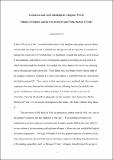Files in this item
Catholicism and anti-Catholicism in Arlington’s world : polemic, persuasion and the conversion of Anne Hyde, Duchess of York
Item metadata
| dc.contributor.author | Rose, Jacqueline | |
| dc.contributor.editor | Eagles, Robin | |
| dc.contributor.editor | Dennehy, Coleman A. | |
| dc.date.accessioned | 2022-01-14T00:34:56Z | |
| dc.date.available | 2022-01-14T00:34:56Z | |
| dc.date.issued | 2020-07-14 | |
| dc.identifier | 259487176 | |
| dc.identifier | 96c8ccd5-8922-43ec-9bd4-fbc05f24787b | |
| dc.identifier.citation | Rose , J 2020 , Catholicism and anti-Catholicism in Arlington’s world : polemic, persuasion and the conversion of Anne Hyde, Duchess of York . in R Eagles & C A Dennehy (eds) , Henry Bennet, earl of Arlington, and his world : restoration court, politics and diplomacy . Politics and culture in Europe, 1650-1750 , Routledge Taylor & Francis Group . < https://www.taylorfrancis.com/books/e/9781003053309/chapters/10.4324/9781003053309-5 > | en |
| dc.identifier.isbn | 9780367513108 | |
| dc.identifier.isbn | 9781003053309 | |
| dc.identifier.other | ORCID: /0000-0001-7019-294X/work/78891599 | |
| dc.identifier.uri | https://hdl.handle.net/10023/24659 | |
| dc.description.abstract | Conversions to Catholicism at the later Stuart court are usually associated with political crises and panic over popery. While the experience of the most famous convert, James duke of York, the future James II, fits this model, that of his first wife Anne Hyde challenges it. Anne’s quiet conversion shortly before she died resembles Arlington’s own change of religion revealed when he called for a Catholic priest just before his death. Setting Anne’s turn to Catholicism in the context of recent work on conversion, this chapter explores both her change of faith and reactions to it. It interrogates Anne’s ‘conversion narrative’ to explore its textual history and how typical it was of converts, especially elite converts, to Catholicism. It then considers reactions to these events, particularly those of Anne’s father, the exiled Edward Hyde, earl of Clarendon, and of Anne’s former spiritual adviser George Morley, bishop of Winchester, to show how responses were shaped by questions of status, gender and family relationships, as well as by a sensitivity to the political damage caused by rumours of popery – rumours which in the 1650s had been associated with both the exiled royal family and Arlington himself. Since Clarendon’s response was expressed in a number of different works, ranging from meditative commentary on the Psalms to essays, and from correspondence to his daughter to polemical attacks on Catholic theologians, comparisons will be made between the various ways in which opposition to Catholicism was expressed in different settings. That Anne’s conversion took place in 1670, when Arlington’s power was reaching its height, and that a renewed argument about it broke out in the early to mid-1680s, just before Arlington’s death, is intriguing. Both offer suggestive examples of politically successful conversions to Catholicism, despite the anti-popish fervour that pervaded Arlington’s world. | |
| dc.format.extent | 354562 | |
| dc.language.iso | eng | |
| dc.publisher | Routledge Taylor & Francis Group | |
| dc.relation.ispartof | Henry Bennet, earl of Arlington, and his world | en |
| dc.relation.ispartofseries | Politics and culture in Europe, 1650-1750 | en |
| dc.subject | BDC | en |
| dc.title | Catholicism and anti-Catholicism in Arlington’s world : polemic, persuasion and the conversion of Anne Hyde, Duchess of York | en |
| dc.type | Book item | en |
| dc.contributor.institution | University of St Andrews. School of History | en |
| dc.date.embargoedUntil | 2022-01-14 | |
| dc.identifier.url | https://www.routledge.com/9780367513108 | en |
| dc.identifier.url | https://www.taylorfrancis.com/books/e/9781003053309/chapters/10.4324/9781003053309-5 | en |
This item appears in the following Collection(s)
Items in the St Andrews Research Repository are protected by copyright, with all rights reserved, unless otherwise indicated.

